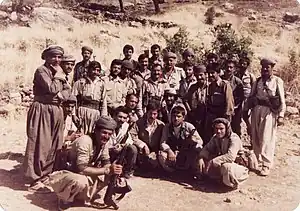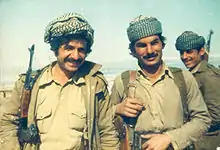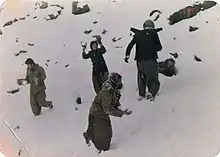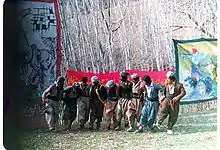Al-Ansar (Iraq)
Al-Ansar (Arabic: الأنصار, 'the Partisans') was the paramilitary wing of the Iraqi Communist Party, active between 1979 and 1988.
| Al-Ansar الأنصار | |
|---|---|
| Leaders | Toma Tomas |
| Dates of operation | 1979 – 1988 |
| Headquarters | Kirkuk Sulaymaniyah Aden (South Yemen) |
| Active regions | |
| Ideology | Communism Secularism Marxism-Leninism Anti-fascism Self-determination |
| Size | 10.000? |
| Allies | |
| Opponents | |
Early phase
| Al-Ansar insurgency | |||||||
|---|---|---|---|---|---|---|---|
| Part of Iraqi–Kurdish conflict | |||||||
 Al-Ansar partisans in Northern Iraq | |||||||
| |||||||
| Belligerents | |||||||
|
| Al-Ansar | ||||||
| Commanders and leaders | |||||||
|
| Toma Tomas | ||||||


When the alliance between the Iraqi Communist Party and the Iraqi Ba'ath Party ended, a wave of harsh repression against the communists followed. In 1977 the regime launched a crackdown against the communists. A number of communists fled to the Kurdish areas in northern Iraq, which was outside Ba'ath control, to escape arrest. By January 1979, the exiled communists had established Al-Ansar. By April 1979, the al-Ansar movement was active. Headquarters of the al-Ansar units were established in Kirkuk and Sulaymaniyah, and bases were established in Erbil. Later, bases were also set up in Dohuk and parts of Nineveh. The build-up of al-Ansar occurred without the full permission of the politburo of the Iraqi Communist Party.[1]
In South Yemen, a number of Al-Ansar began their military training before joining the guerrillas in northern Iraq. The training was administered by the South Yemeni government.[2]
Communist Party adopts armed struggle as its line of action

In 1980, Nahj al-Ansar (نهج الأنصار, 'Path of the Partisans'), the newspaper of Al-Ansar was launched. In November 1981 the Iraqi Communist Party officially adopted armed struggle as part of the struggle of the party and established up a Central Military Bureau as a unified command to lead the Al-Ansar movement. By that time, Al-Ansar forces operated throughout all Kurdish provinces of Iraq.[1]
In 1982 a Central Military Council was held clandestinely. It was attended by the Iraqi Communist Party general secretary, politburo, and Al-Ansar commanders. The Council set up the overall strategic line of the armed struggle. By this time a decentralized command structure had been adopted, enabling the partisan forces more flexibility in their confrontations with Iraqi government troops.[1]
Pasht Ashan massacre
The Iraqi Communist Party made a deal with the Patriotic Union of Kurdistan (PUK), one of the two main Kurdish factions. However, only two weeks after the deal with PUK, the Iraqi Communist Party shifted its alliances to the arch-rival of PUK, the Kurdistan Democratic Party (KDP). This shift of alliance was caused by the PUK's willingness to make a peace agreement with Saddam Hussein's regime. As an immediate result of the shift, al-Ansar was put in the line of fire between the two warring Kurdish parties, KDP and PUK. In May 1983 al-Ansar forces entered the Pasht Ashan area, a zone that both PUK and KDP claimed as part of their sphere of influence. PUK forces attacked the Iraqi Communist Party headquarters, and massacred 150 al-Ansar fighters and other Iraqi Communist Party members.[3] A radio station run by the Iraqi Communist Party was destroyed by the PUK's faction of the Peshmerga. The PUK' Peshmerga also seized ammunitions and food supplies of al-Ansar. Several Iraqi Communist Party members, including members of the party politburo, were captured by PUK. After the PUK's attacks on al-Ansar, they were no longer en effective guerrilla force.[3]
Within the Iraqi Communist Party-Central Command (a group which broke off from the Iraqi Communist Party because they had opposed the alliance between the Iraqi Communist Party and Saddam Hussein's Ba'ath Party), claims were made that the Pasht Ashan massacre had been deliberately provoked by the Iraqi Communist Party leadership. According to this version of events, the Iraqi Communist Party leadership used the killings to remove opposition from within the party (who called for the holding of a new party congress).[4]
End of the movement
In June 1987 the movement suffered another severe set-back, as over 150 fighters were killed. The report to the 1998 sixth party congress of the Iraqi Communist Party identified that confusion between the politburo and the local guerrilla forces had been the cause of the defeat.[5]
The June–July 1987 meeting of the Central Committee of the Iraqi Communist Party decided to put al-Ansar in control of the Kurdish faction of the party after the Arab faction failed to lead it. However, by that time, al-Ansar was largely defunct.[5] According to estimates from the Iraqi Communist Party, around 1,200 of al-Ansar were killed during nine years of armed struggle.[6]
Veterans' Society
In 2004 an organization of veterans of the al-Ansar, Iraqi Communist Partisans Society, was founded at a conference in southern Sweden. The Society has branches both in Iraq and in exile.[2]
See also
References
- Ismael, Tareq Y. The Rise and Fall of the Communist Party of Iraq. Cambridge/New York: Cambridge University Press, 2008. p. 184, 294
- Al-Istashari, Al-Muhandis; Kabbah, Salam Ibrahim Atuf (June 30, 2007). "الأنصار الشيوعيون العراقيون ... الريادة والمعالم التاريخي". Tariq ash-Shaab. Iraqi Communist Party. Retrieved 3 January 2009.
- Ismael, Tareq Y. The Rise and Fall of the Communist Party of Iraq. Cambridge/New York: Cambridge University Press, 2008. pp. 201-202
- Ismael, Tareq Y. The Rise and Fall of the Communist Party of Iraq. Cambridge/New York: Cambridge University Press, 2008. p. 202
- Ismael, Tareq Y. The Rise and Fall of the Communist Party of Iraq. Cambridge/New York: Cambridge University Press, 2008. p. 270, 294
- Abu Natasha. "كان اليزيديون جزءا من حركة الأنصار الشيوعيين". Tariq ash-Shaab. Iraqi Communist Party. Retrieved 3 January 2009.